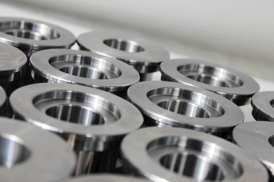
Nano diamond is diamond particles made by explosive method, the surface functions can help the particles have a positive charge so as to be coated with metal ions during electroplating process.
Nano diamond is diamond particles made by explosive method, the surface functions can help the particles have a positive charge so as to be coated with metal ions during electroplating process. Nanodiamond particles are hardwearing, small, and offer very low surface friction. Since their discovery in cold war Russia, they have been a little-known secret used to improve the performance of hard chrome plating. Platers have added liquid suspensions containing clusters of these diamond particles into the electrolyte and experienced significant improvements in durability of the plating for such applications as gun barrels and machine parts. NanoDiamonds are synthesised by a detonation process which results in diamond particles with surface functionalisation, enabling them to have a positive charge in solution and to deposit together with the metal ions in the plating process.
While currently, Carbodeon company is developing nano diamond revised type to achieve surface functionalization, such as electroplated processing applications, compared with traditional nano diamond , particle charge will rise by 50%. By increasing extra separating force, the company can develop diamond particles liquid dispersion liquid whose diameter is 4nm to 6nm and has changed nano diamond cluster crystal whose diameter ranges from 100nm to several micrometer.

The research result is to increase the quantity of nano diamond on material surface according to one to two quantity levels. To make real nano particles embedded in metal electroplating film, Carbodeon company plans to add extra diamond on the metal electroplating surface so as to save more costs. Carbodeon has developed modified versions of these nanodiamonds, where the surface functionalization is specifically controlled. For plating applications, the result is that the particle charge or "zeta potential" is much higher - around 50 percent more than traditional nanodiamonds.
This creates an additional separation force between the nanodiamond particles and has enabled Carbodeon to develop a liquid dispersion of individual 4-6nm particles instead of the traditional clusters measuring from 100nm up to a few microns in size.
The result is that the surface area to volume ratio of the diamonds increases by one to two orders of magnitude. By depositing genuine nanoscale particles into metal plating, Carbodeon aims to make the addition of nanodiamond to metal plating more economic.
Vesa Myllymaki, CTO, explained: "Throughout our work at Carbodeon, we have focused on delivering unagglomerated nanodiamond particles into parent materials in order to achieve material improvements with substantially less than 1wt% diamond content, where previously people have used several percent diamond content in agglomerated form and gained less performance than we have. We have already achieved this with nanodiamonds in polymer coatings and thermal compounds, and now we have proved it is also possible in certain types of metal plating."
While the traditional dosage rate for plating with agglomerated nanodiamonds is 10g/litre of electrolyte, the optimum dose using dispersed nanodiamond in electroless nickel has been found to be just 0.05 g/litre. GDOES (glow discharge optical emission spectroscopy) shows the diamond content in the plating to be at 0.2%, and SEM (scanning electron microscope) images show the particles having to a large extent been deposited as discrete <10nm particles. Wear testing results using the Taber Rotary Abrasion method shows that the as-plated medium phosphorous electroless nickel has a wear index of 6, compared to 18 of the unmodified plating - a 3x improvement.
"Success with nanodiamonds means achieving more with less, and we have done that," said Vesa Myllymaki. "The cost of the diamond in the process is less than the cost of the nickel, and in terms of the total component or system value, this is a really economic way of upgrading the performance of the plated surface."
Author: Liwei Chu
Copyright: iAbrasive.com–Abrasives & Diamond Tools Market